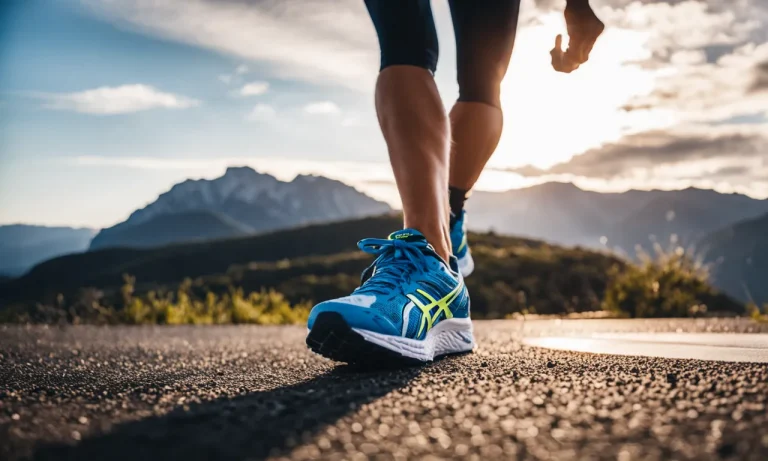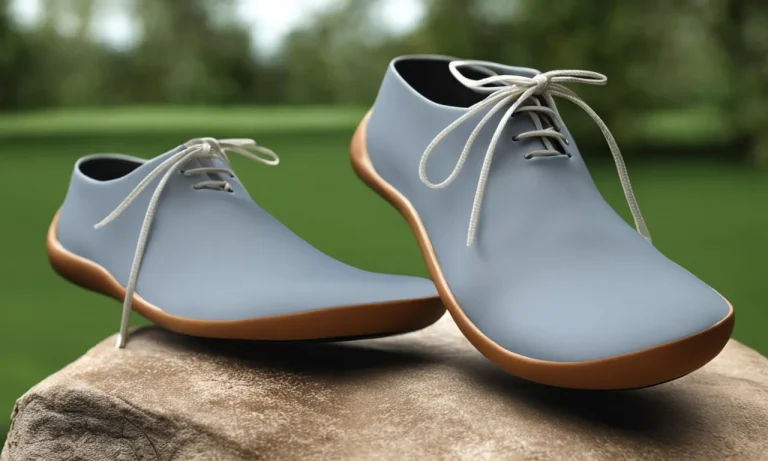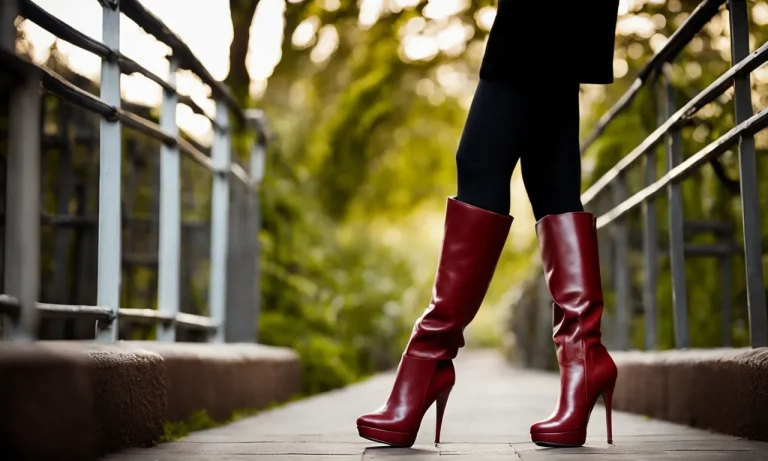Hiking in the rain can be exhilarating, but only if you have the right gear. The wrong boots will leave your feet cold, wet, and blistered. But the right rain boots for hiking will keep your feet comfortable and dry no matter the conditions on the trail.
If you’re short on time, here’s a quick answer to your question: Look for lightweight, waterproof hiking boots with good traction and ankle support. Brands like Merrell, Columbia, Keen, and Salomon make high-quality rain hiking boots.
What to Look for in Rain Boots for Hiking
Waterproof Materials
When it comes to rain boots for hiking, one of the most important factors to consider is the level of waterproofing. Look for boots that are made from high-quality, durable materials such as rubber or neoprene.
These materials are known for their excellent waterproof properties, keeping your feet dry even in the wettest conditions. Additionally, some boots may feature a waterproof membrane or coating to provide an extra layer of protection against moisture.
Traction and Grip
While hiking in rainy and muddy conditions, it’s crucial to have proper traction and grip to prevent slips and falls. Look for rain boots that have a sturdy and aggressive outsole pattern, designed to provide excellent traction on slippery surfaces.
Some boots even incorporate specialized technologies like Vibram soles, which are known for their exceptional grip and durability.
Weight
When hiking, every ounce matters, so it’s essential to choose rain boots that are lightweight. Heavy boots can weigh you down and make your hiking experience more tiring. Look for boots that are made from lightweight materials without compromising on durability.
This will allow you to hike comfortably and effortlessly, even in wet conditions.
Breathability
While keeping your feet dry is important, it’s equally crucial to ensure breathability in your rain boots. Look for boots that have breathable linings or mesh panels, allowing air circulation to prevent your feet from becoming sweaty and uncomfortable.
This will help to regulate temperature and keep your feet feeling fresh, even during long hikes.
Ankle Support
When hiking, ankle support is crucial to prevent injuries and provide stability on uneven terrain. Look for rain boots that offer good ankle support, with a higher shaft that extends above the ankle. This will help to minimize the risk of twisting or spraining your ankle while hiking in wet and slippery conditions.
Comfort Features
Comfort is key when it comes to hiking footwear, so look for rain boots that offer additional comfort features. These can include cushioned insoles, padded collars, or adjustable straps. Some boots may also have a contoured footbed or arch support, providing added comfort and reducing fatigue during long hikes.
The Best Rain Boot Materials for Hiking
When it comes to choosing the best rain boots for hiking, the material of the boots plays a crucial role in determining their durability, comfort, and overall performance. Here are three popular materials that are commonly used in rain boots for hiking:
Full-Grain Leather
Full-grain leather is a top-notch material known for its exceptional durability and water-resistance. It is made from the outermost layer of cowhide, which makes it highly resistant to water, mud, and other elements you may encounter while hiking.
Full-grain leather boots are not only sturdy but also provide excellent ankle support, making them a great choice for rugged terrains. Additionally, they offer a classic and timeless look that many hikers appreciate.
However, they may require a break-in period and regular maintenance to keep them in optimal condition.
Synthetic Materials
Synthetic materials, such as nylon or polyester, are commonly used in rain boots for hiking due to their lightweight nature and flexibility. These materials are often combined with waterproof membranes, creating a breathable and waterproof barrier that keeps your feet dry and comfortable.
Synthetic rain boots are also known for their quick-drying capabilities, making them ideal for wet hiking conditions. Moreover, they are typically more affordable than full-grain leather boots, making them a budget-friendly option for hikers.
Rubber
Rubber rain boots are a popular choice among hikers due to their excellent waterproof properties. They provide a reliable barrier against water, ensuring that your feet stay dry even in the most challenging weather conditions.
Rubber boots are also highly durable and can withstand rough terrains, making them suitable for hiking adventures. Additionally, they are easy to clean and maintain, as they can be simply wiped off after use.
While rubber boots may not offer the same level of breathability as other materials, they are a reliable choice for hikers seeking waterproof protection.
When choosing the best rain boots for hiking, consider your specific needs and preferences. Whether you opt for the durability of full-grain leather, the lightweight nature of synthetic materials, or the reliable waterproof properties of rubber, investing in high-quality rain boots will enhance your hiking experience and keep your feet dry and comfortable throughout your outdoor adventures.
The Top Brands for Hiking Rain Boots
When it comes to choosing the best rain boots for hiking, it’s essential to consider the brand. A reputable brand ensures durability, comfort, and performance in challenging outdoor conditions. Here are some of the top brands renowned for their high-quality hiking rain boots:
Merrell
Merrell is a well-known brand in the outdoor footwear industry. Their hiking rain boots are designed to provide excellent traction, waterproof protection, and comfort. Merrell rain boots feature advanced technologies such as Vibram outsoles and Gore-Tex membranes, ensuring optimal performance on muddy trails and wet terrain.
Columbia
Columbia is another top brand that offers a wide range of hiking rain boots. Known for their innovative designs and high-quality materials, Columbia rain boots are built to withstand various weather conditions.
They provide excellent grip, insulation, and waterproof capabilities, making them ideal for hiking in rainy and cold environments.
Keen
Keen is a brand that focuses on creating durable and comfortable footwear for outdoor enthusiasts. Their hiking rain boots are no exception. Keen rain boots are known for their toe protection, breathability, and reliable waterproofing.
With features like the Keen.Dry membrane and rugged outsoles, Keen boots provide the necessary support and traction for hiking in wet conditions.
Salomon
Salomon is a trusted brand among hikers and outdoor adventurers. Their hiking rain boots combine functionality, performance, and style. Salomon rain boots feature innovative technologies like Contagrip outsoles and Sensifit systems, ensuring stability and grip on slippery surfaces.
Additionally, they offer excellent ankle support and protection from the elements.
Kamik
Kamik is a brand that specializes in creating reliable footwear for challenging weather conditions. Their hiking rain boots are designed to keep your feet dry and comfortable during outdoor adventures.
Kamik rain boots feature waterproof materials, adjustable closures, and durable construction, making them suitable for hiking in rain, snow, or muddy terrains.
When choosing your hiking rain boots, consider the specific features and technologies offered by each brand. It’s also important to try them on and ensure a proper fit before hitting the trails. Remember, investing in a quality pair of hiking rain boots will enhance your outdoor experience and keep your feet happy and dry!
5 of the Best Rain Boots for Hiking
Merrell Moab 2 Mid Waterproof Boot
The Merrell Moab 2 Mid Waterproof Boot is a top choice for hikers looking for a reliable and durable rain boot. With its waterproof construction, Vibram outsole, and comfortable fit, it offers excellent traction and support on wet and slippery terrain.
Whether you’re hiking through muddy trails or crossing streams, the Moab 2 Mid will keep your feet dry and protected.
Columbia Newton Ridge Plus Waterproof Hiking Boot
The Columbia Newton Ridge Plus Waterproof Hiking Boot is another great option for hikers. It features a waterproof leather upper, a cushioned midsole for comfort, and a durable rubber outsole for traction.
With its lightweight design and superior waterproofing, this boot is perfect for long hikes in wet conditions.
KEEN Targhee III Waterproof Hiking Boot
When it comes to hiking boots, KEEN is a name that stands out. The KEEN Targhee III Waterproof Hiking Boot is no exception. This boot is not only waterproof but also breathable, thanks to its KEEN.Dry membrane.
It offers great ankle support, a comfortable fit, and excellent traction on various terrains. Whether you’re hiking in the rain or trekking through muddy trails, the Targhee III will keep your feet dry and comfortable.
Salomon X Ultra 3 Mid GTX Hiking Boot
The Salomon X Ultra 3 Mid GTX Hiking Boot is a popular choice among hikers for its exceptional performance in wet conditions. It features a Gore-Tex membrane that provides superior waterproofing while still allowing your feet to breathe.
With its aggressive lug pattern and sturdy construction, this boot offers excellent traction and stability on slippery surfaces. Whether you’re hiking in rain or snow, the X Ultra 3 Mid GTX will keep your feet dry and secure.
Kamik Nation Plus Boot
For those on a budget, the Kamik Nation Plus Boot is a great option. This affordable rain boot offers reliable waterproofing, a comfortable fit, and good traction. It features a synthetic rubber upper and a removable thermal liner, making it suitable for colder temperatures as well.
Whether you’re hiking on a rainy day or in snowy conditions, the Kamik Nation Plus Boot will keep your feet dry and warm without breaking the bank.
Finding the Right Fit
When it comes to choosing the best rain boots for hiking, finding the right fit is crucial. Ill-fitting boots can lead to discomfort, blisters, and even injuries. Here are some key factors to consider when determining the right fit for your hiking rain boots.
Size
The first step in finding the right fit is to determine your correct size. It’s important to measure your feet accurately, as different brands may have slightly different sizing charts. You can use a measuring tape or visit a shoe store to get an accurate measurement.
Keep in mind that your feet might swell during long hikes, so it’s recommended to choose boots that are slightly larger to accommodate for this.
If you’re shopping online, be sure to check the brand’s size chart and read reviews from other customers to see if the boots run true to size or if you should consider sizing up or down.
Width
In addition to size, width is another important factor to consider. Not all feet are the same width, and wearing boots that are too narrow or too wide can cause discomfort and foot pain. Most footwear brands offer different width options, so it’s worth checking if the boots you’re interested in come in varying widths.
If you have wider feet, look for boots that have a wider toe box to give your toes more room to move. Conversely, if you have narrower feet, opt for boots that provide a snug fit without feeling too tight.
Break-In Period
It’s important to keep in mind that even the best-fitting rain boots may require a break-in period. This is especially true for boots made of stiffer materials, such as rubber. During the break-in period, the boots will gradually mold to the shape of your feet, providing a more comfortable fit.
To break in your new rain boots, start by wearing them for short periods of time around the house or on shorter hikes. Gradually increase the duration and intensity of your hikes until you feel that the boots have fully conformed to your feet.
This process may take a few weeks, so be patient and don’t rush it.
Remember, finding the right fit is essential for a comfortable and enjoyable hiking experience. Taking the time to measure your feet, consider the width, and allow for a break-in period will help you find the perfect rain boots for your adventures in the great outdoors.
How to Waterproof Your Hiking Boots
When it comes to hiking, having waterproof boots is essential to keep your feet dry and comfortable. Thankfully, there are several methods you can use to waterproof your hiking boots and protect them from the elements.
Here are three effective ways to ensure your boots stay dry during your outdoor adventures.
Spray-On Waterproofing
One of the easiest and most convenient ways to waterproof your hiking boots is by using a spray-on waterproofing product. These products are typically made with a silicone-based formula that creates a protective barrier on the surface of your boots, preventing water from seeping in.
Simply spray the product evenly onto your boots, making sure to cover all areas, and allow it to dry. It’s important to note that different brands may have different application instructions, so always read the label before use.
Pro tip: Look for a spray-on waterproofing product that is specifically designed for outdoor gear and is suitable for the material of your boots. It’s also a good idea to test the product on a small, inconspicuous area of your boots before applying it all over to ensure compatibility.
Waxes and Creams
Another effective method for waterproofing your hiking boots is by using waxes and creams. These products work by conditioning the leather and creating a protective layer that repels water. Apply the wax or cream onto your clean and dry boots using a soft cloth or brush, making sure to cover the entire surface.
Pay extra attention to seams and stitching, as these areas are more prone to water penetration. Allow the product to absorb into the leather and then buff the boots with a clean cloth to remove any excess.
Pro tip: Be sure to choose a wax or cream that is specifically formulated for waterproofing leather boots. Some popular brands include Nikwax, Obenauf’s, and Sno-Seal. Additionally, regularly applying these products can help maintain the durability and longevity of your boots.
Homemade Waterproofing
If you prefer a more DIY approach, you can also try homemade waterproofing methods for your hiking boots. One common method is using a mixture of beeswax and oil, such as coconut oil or lanolin. Melt the beeswax and mix it with the oil in a 1:1 ratio.
Once the mixture has cooled down but is still pliable, apply it to your clean and dry boots using a cloth or brush. Make sure to work the mixture into the leather and concentrate on areas that are more likely to come into contact with water.
Allow the boots to dry and then buff them with a clean cloth.
Pro tip: Homemade waterproofing methods can be a cost-effective option, but keep in mind that they may not offer the same level of protection as commercial products. It’s also important to note that homemade mixtures may alter the appearance of your boots, so test it on a small area first.
Care and Maintenance Tips
Proper care and maintenance of your rain boots are essential to ensure their longevity and effectiveness. Here are some tips to keep your rain boots in great condition:
Cleaning
After every hike, it’s important to clean your rain boots to remove dirt, mud, and other debris. Use a soft brush or cloth to gently scrub the surface of the boots. Avoid using harsh chemicals or abrasive cleaners as they can damage the material.
For stubborn stains, you can use a mild soap solution or a specialized boot cleaner. Rinse the boots thoroughly with water and let them air dry.
Drying
Proper drying is crucial to prevent the growth of mold and mildew inside your rain boots. After cleaning, make sure to dry them thoroughly. Remove any moisture from the interior by stuffing the boots with crumpled newspapers or using boot dryers.
Avoid placing them near direct heat sources, as excessive heat can damage the material. Allow them to air dry in a well-ventilated area.
Storage
When not in use, store your rain boots in a cool, dry place away from direct sunlight. Avoid folding or creasing them, as this can cause cracks and damage the material. Consider using boot shapers or stuffing the boots with newspaper to help them maintain their shape.
Additionally, storing them upright or hanging them can prevent any bending or misshaping.
Inspection
Regularly inspect your rain boots for any signs of damage or wear. Check for cracks, tears, or loose seams. If you notice any issues, it’s best to address them promptly to prevent further damage. Consider applying a waterproofing spray or conditioner to enhance the longevity of your rain boots and maintain their water resistance.
Remember, taking care of your rain boots not only extends their lifespan but also ensures they continue to provide reliable protection and comfort during your hiking adventures. By following these care and maintenance tips, you can enjoy your rain boots for years to come.
Conclusion
With the right pair of waterproof hiking boots, you can comfortably hit the trails rain or shine. Look for lightweight boots with ankle support, strong traction, and waterproof sealed materials. Brands like Merrell, Columbia, Keen and Salomon make high-quality hiking rain boots designed for the trail.
Focus on fit and features like grip and breathability to find the perfect pair of rain boots that will keep your feet dry hike after hike. With proper care and maintenance, your waterproof hiking boots can last for years of rugged use on the trail.






